August 07, 2015
By Brad Miller, Ph.D.
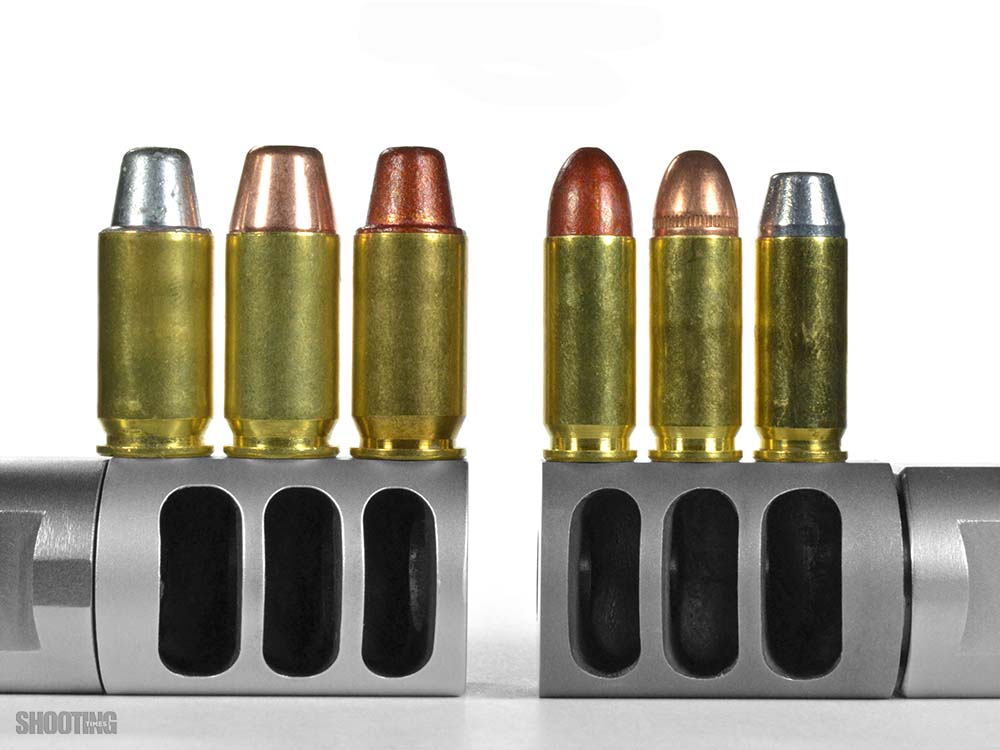 The .45 ACP is much-maligned when it comes to talk about putting a compensator on one. "It doesn't produce enough pressure to make the compensator work," is often cited as the reason why it's not worth it. That myth was busted. Empirical tests showed that a compensator works very well on a .45 ACP, reducing muzzle rise up to 50 percent. That said, the compensated .38 Super was more effective, reducing muzzle rise by up to 79 percent.
The .45 ACP is much-maligned when it comes to talk about putting a compensator on one. "It doesn't produce enough pressure to make the compensator work," is often cited as the reason why it's not worth it. That myth was busted. Empirical tests showed that a compensator works very well on a .45 ACP, reducing muzzle rise up to 50 percent. That said, the compensated .38 Super was more effective, reducing muzzle rise by up to 79 percent.
If you compared the amount of muzzle rise between the .45 ACP and the .38 Super in that article, there was a big difference between the two calibers. The compensated .45 had over three times the muzzle rise as the .38, which might give the reader the impression that even though a compensator works on a .45 ACP, it will never shoot as flat as a .38 Super. However, that article used 230 grain bullets in the .45 and 115 grain bullets in the .38. That's not exactly a apples-to-apples comparison.
Bullet weight matters. Light bullets have less muzzle rise than heavy bullets when they are fired through a compensator at the same power factor. The extra gunpowder required by the lighter bullets to reach their required higher velocity produces more gas to drive the compensator's effect.
Caliber matters. A comparison of recoil in different pistol calibers with no compensator showed that when driving bullets of the same weight to the same velocity, smaller calibers had less recoil, likely due to using less gunpowder.
Advertisement
Since larger calibers require more gunpowder, and this extra gunpowder enhances compensator effectiveness, it begs the question whether a compensator could be as effective on a .45 as it is on a .38 when they use the same bullet weight. The apparent obvious answer might be "no", because the .45 is still a low pressure cartridge and compensators deflect gas pressure for their effect. This was tested.
The experiment was designed to make the guns and ammunition as equal as possible. For the gun, this means weight and compensator design. For the ammunition, this means the same bullet type, weight, gunpowder, primer and, when possible, cartridge overall length (COL).
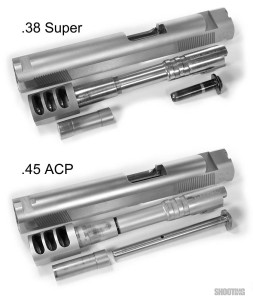 The Gun
The Gun
Advertisement
The same pistol frame was used. Changing calibers/configurations meant just changing the top end assembly. The .38 Super and .45 ACP top ends both had Caspian slides, 5" Clark barrels and EGW three-port cone compensators with identical port designs (Figures 1, 2). The same 12 lb recoil spring was used with all top ends.
The .45 caliber barrel is lighter because both barrels have the same outside diameter, but a .45 caliber hole removes more metal than a .38 caliber hole. To compensate for the .38 barrel's greater weight, its top end assembly was equipped with a standard length recoil spring guide rod, while the .45 top end was equipped with a full-length stainless steel recoil spring guide rod. In this configuration, the .38 top end weighed 0.35 oz more than the .45 top end. (0.35 oz = 153 grains, which is less than the weight of one of the bullets used in this test.) Granted, the barrels are considered part of the moving parts and the guide rods are not.
The exit hole in the .38 compensator was 0.369" (nominal bore diameter 0.356") and for the .45 was 0.465" (nominal bore diameter 0.451"). Both provided a close fit to the bullets, which minimizes gas leak around the bullets and maximizes gas trapping and deflection (Figure 3).
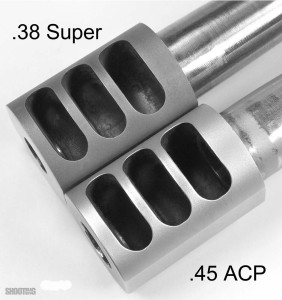 In addition to the compensated top end assemblies, non-compensated top ends were also used to compare the amount of muzzle rise reduction offered by the compensators. The same slides were used. The .45 used a Para Ordnance 5" barrel, and the .38 used a Kart 5" barrel. Their weight was matched exactly with a full-length tungsten guide rod paired with the .45, and a standard length guide rod with the .38.
In addition to the compensated top end assemblies, non-compensated top ends were also used to compare the amount of muzzle rise reduction offered by the compensators. The same slides were used. The .45 used a Para Ordnance 5" barrel, and the .38 used a Kart 5" barrel. Their weight was matched exactly with a full-length tungsten guide rod paired with the .45, and a standard length guide rod with the .38.
Bullets
Three different bullet weights were tested; 160, 170 and 180 grains. The 160 grain bullets were polymer coated cast Bayou bullets. For the .45 caliber bullets, their 185 grain SWC bullets were used, but their weight was reduced to 160 grains by drilling a hole in the base (Figure 4). The 180 grain bullets were cast Penn Bullets. Their .38 bullets were listed for a .38/.357 revolver. They sized them to 0.356 for use in the .38 Super.
The jacketed bullets were Sierra .38/.357 caliber 170 grain FMJ bullets for the .38 Super and Hornady 185 grain HAP bullets for the .45. Lead was removed from the hollow point of the .45 bullets to reduce their weight to 170 grains (Figure 4).
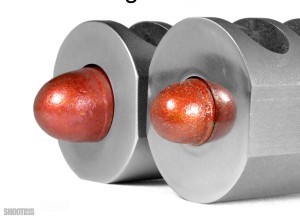 Bullets of the same weight were loaded to the same or similar overall length, though this was not possible with the 180 grain bullets. The 180 grain .38 Super bullet required a shorter overall length to fit in the chamber than the 180 grain .45 ACP bullet.
Bullets of the same weight were loaded to the same or similar overall length, though this was not possible with the 180 grain bullets. The 180 grain .38 Super bullet required a shorter overall length to fit in the chamber than the 180 grain .45 ACP bullet.
Ammunition
Ammunition was loaded with the same gunpowder and primer (Federal #205 small rifle). The .45 ACP was loaded in Blazer small primer cases. The .38 Super was loaded in Starline .38 Super Comp cases.
Two gunpowders, Accurate No. 7 and Alliant Unique, were used to test whether different gunpowders would produce the same results. Unique requires less weight than Accurate No. 7 for the same velocity, thus provides less gas for the compensator. The ammunition was loaded with two to four charge weights to produce a recoil profile and to permit linear regression analysis.
The test design produced six (6) comparisons = three bullet weights with two gunpowders.
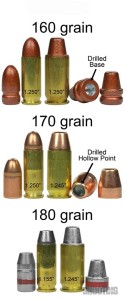 Additional ammunition was loaded with Bayou Bullets' polymer coated 115 grain .38 Super caliber and 230 grain .45 caliber bullets with Accurate No. 7 to compare muzzle rise with these bullet weights. A total of 750 rounds was fired; 490 through the compensated barrels and 260 through the non-compensated barrels.
Additional ammunition was loaded with Bayou Bullets' polymer coated 115 grain .38 Super caliber and 230 grain .45 caliber bullets with Accurate No. 7 to compare muzzle rise with these bullet weights. A total of 750 rounds was fired; 490 through the compensated barrels and 260 through the non-compensated barrels.
Measuring recoil
The gun was fired from a Ransom Rest. Measuring the distance that the gun moves in the Ransom Rest indicates relative recoil. The rocker arm that holds the gun pivots upward when the gun is fired. Since the compensator redirects the gas upward, it produces a reciprocal downward force that reduces how far the gun pivots. Thus the Ransom Rest provides an objective method to measure gas force effectiveness with a compensator.
Ransom Rest (RR) movement and gunpowder weight required to reach a specific velocity were calculated for 165 power factor (PF) with linear regression. PF is calculated by bullet weight times velocity divided by 1000. Lighter bullets have to go faster to make the PF. For example, a 160 grain bullet has to travel 1031.3 fps and a 180 grain bullet must travel 916.7 fps.
PF is an ammunition power level mandated by some organized shooting sports and determines how targets are scored. Compensated guns are most often used in practical shooting competition, and 165 PF was selected because it is the minimum power level allowed for Major PF scoring in USPSA Open Division where compensators are allowed.
Results
Recoil with No Compensator
The first data presented shows Ransom Rest (RR) movement when fired without a compensator to orient the reader to recoil profile figures and to how these calibers behave without a compensator's effect. The left side of Figure 5 is a scatterplot with lines that shows the recoil profiles of 160 grain bullets loaded with Accurate No. 7. The .45 line is above the .38 line, indicating the .45 produces more RR movement when they fire the same bullet weight. This means the .45 produces more recoil. The bar graph on the right shows RR movement at 165 PF (1031 fps). The .45 moved an average of 6.2mm farther than the .38. Calculating recoil force using gunpowder charge weights derived from linear regression shows that the .45 produces more recoil force than the .38 (5.84 ft-lbs. and 4.65 ft-lbs., respectively in a 2.5 pound gun). The reason why the .45 produces more recoil is that it requires more gunpowder to propel the same bullet weight to the same velocity. The .45 required 12.4 grains of Accurate No. 7, but the .38 required only 6.6 grains.
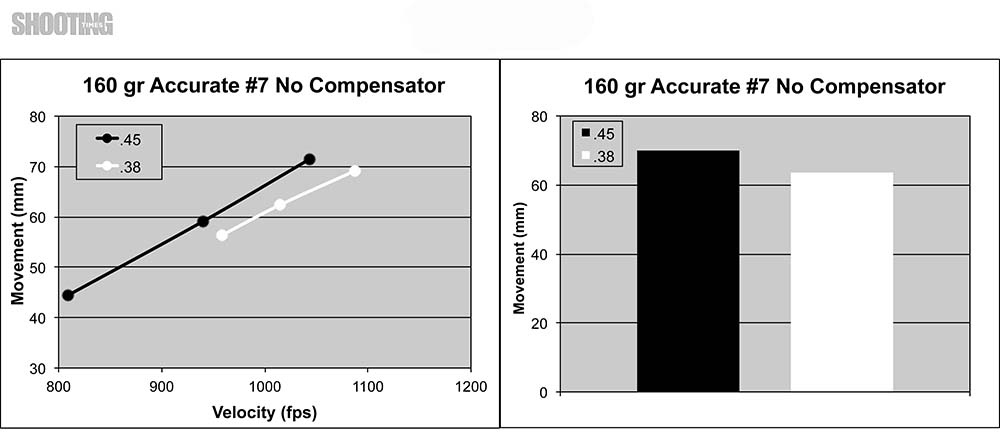 Three other loads were fired through the non-compensated barrels: 160 grain bullets with Unique, and 180 grain bullets with Accurate No. 7 and Unique. They produced the same result: the .45 always had more RR movement, and required more gunpowder, than the .38 for the same velocity.
Three other loads were fired through the non-compensated barrels: 160 grain bullets with Unique, and 180 grain bullets with Accurate No. 7 and Unique. They produced the same result: the .45 always had more RR movement, and required more gunpowder, than the .38 for the same velocity.
Recoil with a Compensator
RR movement with the compensated barrels was completely different. The compensated .45 produced the same or less muzzle rise than the compensated .38 in every comparison. Figure 6 shows the 160 grain ammunition loaded with Accurate No. 7 fired through compensated barrels. The recoil profile line of the .45 is now below the .38 line. This means that the compensated .45 had less muzzle rise than the compensated .38. RR movement of the .45 was 3.9mm less than the .38 at 165 PF.
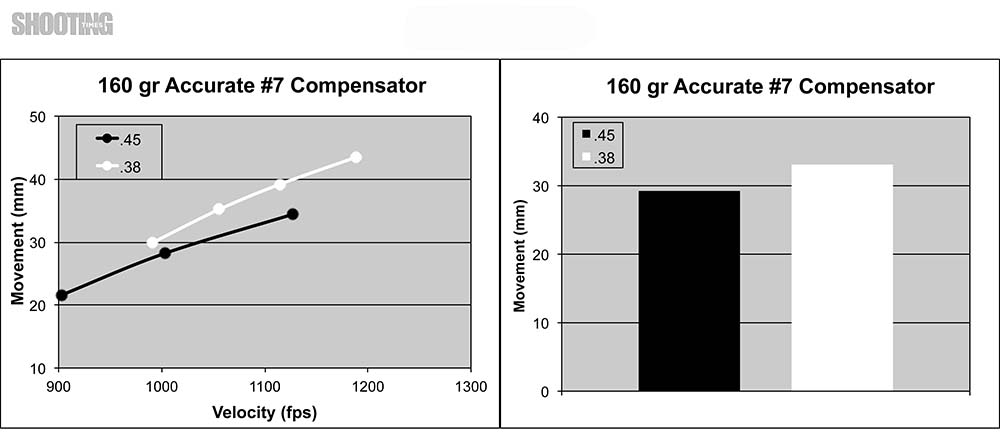 The recoil profiles of the remaining five loads are shown in Figure 7. The recoil profile lines of the 160 grain bullet with Unique and the 170 grain bullet with Accurate No. 7 are clearly separated, and the .45 had less muzzle rise than the .38. The .45 produced 2mm less movement than the .38 at 165 PF in both examples.
The recoil profiles of the remaining five loads are shown in Figure 7. The recoil profile lines of the 160 grain bullet with Unique and the 170 grain bullet with Accurate No. 7 are clearly separated, and the .45 had less muzzle rise than the .38. The .45 produced 2mm less movement than the .38 at 165 PF in both examples.
The recoil profile lines overlap or are very close to one another with the 180 grain bullet with Accurate No. 7 and Unique, and the 170 grain bullet with Unique. In these cases, one could say that the compensated .45 and .38 have the same muzzle rise, although calculations of RR movement at 165 PF revealed that the .45 had less movement than the .38 in each of these comparisons, though the difference was less than 1mm.
Thus, in all six comparisons the .45 had less muzzle rise than the .38 when they fired the same bullet weight through a compensator.
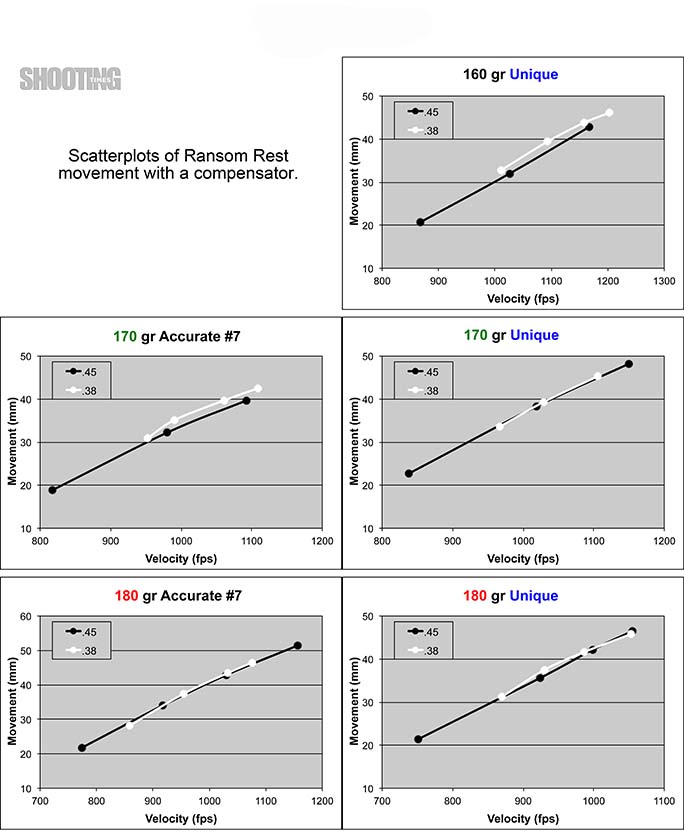 Gunpowder and Gas
Gunpowder and Gas
These comparisons produced a surprising result. The compensated .45 ACP has the same, or less muzzle rise than the compensated .38 Super when they use the same bullet weight. How can the low pressure .45 rival the high pressure .38? It's all about gas.
More gunpowder produces more gas, and more gas produces more recoil force. The .45 used vastly greater gunpowder than the .38 for the same velocity with the same bullet weight because of its larger bore and case volume. The .45 used almost twice the powder as the .38 with Accurate No. 7, and at least 50 percent more with Unique (Table 1) when driving bullets to 165 PF. The extra gunpowder produces more recoil force and this produces more RR movement when the gun has no compensator (Figure 5). But compensators use the extra gas to create more reciprocal downward force, and in this comparison it was enough extra force to keep the .45's muzzle at the same level or below the .38's muzzle (Figures 6 and 7). For a given caliber, lighter bullets produce more recoil force when using the same gunpowder and driven to the same PF because they require more gunpowder.
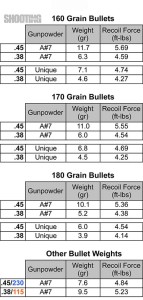 Since the .45 has more muzzle rise than the .38 without a compensator, and less with a compensator, it has a greater reduction in muzzle rise with the compensator. For example, 160 grain bullets loaded with Accurate No. 7 produced a 58 percent reduction in muzzle rise in the .45 when fired through the compensated barrel (Table 2). The same gunpowder in the .38 produced only a 48 percent reduction in muzzle rise. Unique produced less reduction in muzzle rise, because it provides less gas to drive the compensator's effect due to its lower charge weight.
Since the .45 has more muzzle rise than the .38 without a compensator, and less with a compensator, it has a greater reduction in muzzle rise with the compensator. For example, 160 grain bullets loaded with Accurate No. 7 produced a 58 percent reduction in muzzle rise in the .45 when fired through the compensated barrel (Table 2). The same gunpowder in the .38 produced only a 48 percent reduction in muzzle rise. Unique produced less reduction in muzzle rise, because it provides less gas to drive the compensator's effect due to its lower charge weight.
Lighter bullets benefit more from recoil reduction when fired through a compensator. In the .45, 160, 180 and 230 grain bullets show a 58 percent, 52 percent and 38 percent reduction, respectively, when loaded with Accurate No. 7 and driven to the same 165 PF (Table 2). The lightest bullet tested in the .38 Super was 115 grains, and it had a 69 percent reduction in muzzle rise when fired through the compensator with Accurate No. 7, compared to the 160 grain bullet's 48 percent reduction and the 180 grain bullet's 45 percent reduction. This is why many competitive shooters lean toward using the lightest bullets allowed to reduce muzzle rise more for faster followup shots.
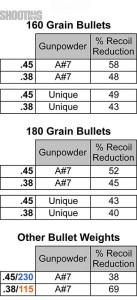 Chamber Pressure Versus Muzzle Pressure
Chamber Pressure Versus Muzzle Pressure
The often cited reason why a compensator on a .45 ACP is ineffective compared to one on a .38 Super is because the .45 is a low pressure round. It's true that the .45 operates at lower chamber pressure and has a much lower pressure limit than the .38. The SAAMI maximum pressure limit for the .45 ACP is 21,000 psi and for the .38 Super is 36,500 psi. But chamber pressure does not tell you what the gas pressure at the muzzle will be, and this is where it matters, because that's where gas pressure adds to the recoil force and where compensators deflect that force.
Peak chamber pressure does not predict muzzle pressure. A gunpowder that uses a larger charge weight can have a lower peak chamber pressure but a higher muzzle pressure than a powder that requires less weight for the same velocity. In simple terms, more gas volume means more gas pressure at the muzzle, and that's what happens here where the two calibers use the same gunpowder. The .45 requires more gunpowder, and this results in high muzzle pressure in spite of its low chamber pressure.
QuickLOAD interior ballistics software (version 3.8.0.2) was used to estimate chamber and muzzle pressure at 165 PF. It showed that the .38's peak chamber chamber was two to four times greater than the .45's, but that the .45's muzzle pressure was roughly equal to the .38's (Table 3) when using bullets of the same weight. The .38 Super's peak chamber pressure declined to an average of one tenth of its peak by the time the bullet exits the muzzle, while the .45 ACP's chamber pressure only declined to an average of one fourth of its peak. This helps to explain why the low pressure .45 can have such a profound reduction in muzzle rise with a compensator when comparing same weight bullets; the gas pressure at the muzzle remains high because of all that gunpowder!
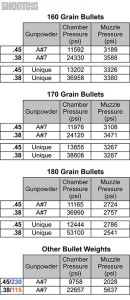 Lighter bullets also produce more muzzle pressure, because they require more gunpowder to reach the same PF. It's the higher pressure that helps compensators to reduce muzzle rise more with lighter bullets.
Lighter bullets also produce more muzzle pressure, because they require more gunpowder to reach the same PF. It's the higher pressure that helps compensators to reduce muzzle rise more with lighter bullets.
Contrary to what is often said, the difference in effectiveness between the compensated .45 ACP and compensated .38 Super is not because the .45 is a low pressure round and the .38 is a high pressure round. The real difference is the weight of bullet they typically shoot. When tested on equal ground using the same weight bullets, the compensated .45 can actually produce less muzzle rise than the .38.
The big player is the difference in the amount of gunpowder required by the two calibers. The .45 uses significantly more gunpowder to drive the same bullet weight to the same speed when using the same gunpowder. The extra gunpowder means the .45 produces more recoil force than the .38. This means the .45 has more muzzle rise when fired in guns with no compensator. But the compensator changes this, and now the .45's extra gunpowder recoil force is directed upwards which creates more downward force. This results in the .45 having equal or less muzzle rise than the .38. That's the power of gas!
If you think about it, it makes sense. The same general principle applies whether you're using two different gunpowders in the same caliber or the same gunpowder in different calibers. It's the same bullet weight at the same speed, but one requires more gunpowder. More gunpowder means more muzzle rise with no compensator, but less muzzle rise with a compensator.
I don't expect people to trade in their compensated .38 Super raceguns for a compensated .45 ACP. The .38 has the advantage of using lighter bullets for even less muzzle rise and more rounds in a magazine of the same length. But these results should kill the myth that a compensator doesn't work well on a .45. It's just that those fat .45 bullets are so damn heavy!
*To estimate the internal space of the cartridges with the bullets which had a hole drilled in the base to reduce weight, lead was shaved off the base of a bullet and its length was used in the QuickLOAD calculations. Some of the estimated pressures for the .38 Super exceeded the SAAMI maximum average pressure limit for this cartridge. The author has experience with excess pressure ammunition and was very cautious during testing by starting with low charge weights and worked up gradually while watching for pressure signs. For reference, proof loads for the .38 Super are as high as 52,640 psi (SAAMI Manual, 1993.) In addition, the .38 Super barrel provided full case support, which is critical in preventing case blowout from excess pressures. The author does not recommend loading any cartridge past SAAMI maximum average pressure limits unless the user is willing to accept all risks associated with this potentially dangerous procedure.

